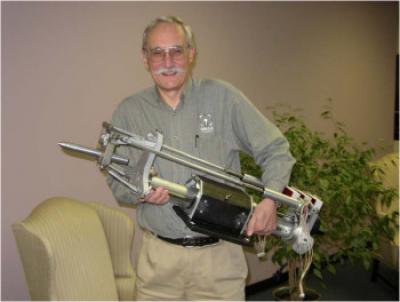You don’t get much closer to the spirit of engineering than in the beginnings of waterjet cutting.
“I got started years ago, in about ’71,” said Dr. John Olsen, one of the originators of waterjet technology and currently VP of operations at Omax Abrasive Waterjets. “I had been reading about some experiments done on rock cutting in England and a friend of mine and I thought it would be fun to try and build a pump and cut something. That was a kind of back-alley operation; it was in my garage and his garage.” Dr. John Olsen is pictured above holding a tilting head waterjet with two linear actuators.
It might sound like many of the stories you hear about start-ups in Silicon Valley today, but the connections between waterjet and computing technologies run deeper than that, as Dr. Olsen explained:
“Oddly enough, one of the biggest changes that made abrasivejets practical was the advent of the PC. A jet is not a very rigid tool—it bends all over the place and makes taper and what-have-you. To make precision parts, you need quite a bit of computing power to predict what the shape of the jet will be so that you can compensate for it. At the time, we were told ‘Nobody will ever accept a PC on the factory floor. Doesn’t that sound funny today?”
> > > Continue here to the full article images and guide





